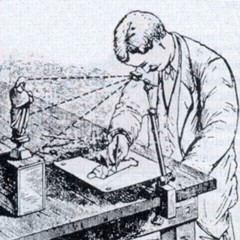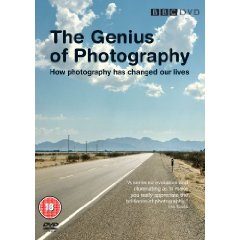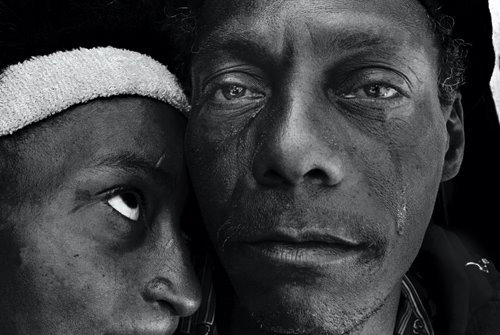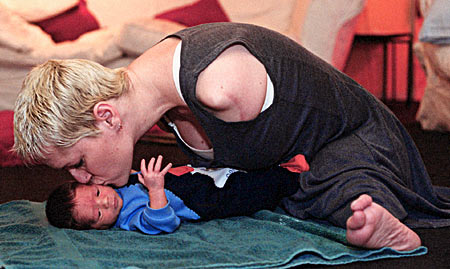 Researchers say anyone can learn to innovate like Steve Jobs.STORY HIGHLIGHTS
Researchers say anyone can learn to innovate like Steve Jobs.STORY HIGHLIGHTS
- After a six-year study, researchers say they have identified the secrets of being a great innovator
- Innovation is not an inherent trait, it's a set of skills that anyone can learn
- Exposing yourself to new ideas and observing the world around you can drive innovation
RELATED TOPICSLondon, England (CNN) -- Coming up with brilliant, game-changing ideas is what makes the likes of Apple's Steve Jobs so successful, and now researchers say they have identified the five secrets to being a great innovator
Professors from Harvard Business School, Insead and Brigham Young University have just completed a six-year study of more than 3,000 executives and 500 innovative entrepreneurs, that included interviews with high-profile entrepreneurs including Amazon founder Jeff Bezos and Michael Dell, founder of Dell computers.
In an article published in December's Harvard Business Review the researchers identified five skills that separate the blue-sky innovators from the rest -- skills they labeled associating, questioning, observing, experimenting and discovering.
Sunday 29 November 2009
Learn the five secrets of innovation - CNN.com
25 Blogs To Help You Stay Current With Social Media | FreelanceFolder
Most of us agree that social media is valuable — but keeping up with the latest trends can be difficult given the speed at which social media is growing and changing.
The big sites like Twitter, Facebook, and LinkedIn are easy to folllow, but there are many others that often get ignored such as Docstoc, Scribd, Slideshare. With all the different platforms, it’s hard to be able to keep up with everything that is new.
In this post we’ve listed 25 of the best social media blogs out there. Read through some of these blogs and you’ll quickly find yourself getting an edge in the social media world.
Click on link to read article
Saturday 28 November 2009
Top 10 movie flops of the decade - from Reuters
LOS ANGELES (Hollywood Reporter) - Movie flops aren't just about losing money. Yes, big budgets that go bust are one consideration. But flops are also about lofty expectations dashed and high profiles brought low. They trigger embarrassing catcalls from the peanut gallery and a general whoever-thought-that-was-a-good-idea-in-the-first-place bewilderment.
Any judgments of flopitude are necessarily subjective, but here are 10 movies from the past decade that made those few moviegoers who saw them cringe. Disagree? Talk among yourselves.
Click on link to read article
WHAT IS ART? - No. 1 – Antony Gormley and art as quintessentially spiritual experience.

Art - as quintessentially spiritual experience
I am presenting a range of artists who mean a lot to me. I'm doing this in the context of a working definition of art - and the view that both the making of art, by the artist, and aesthetic experience, by the viewer are essentially one and the same as mystical or spiritual experience.
What of the definition of art? Here is the one I work with;
Art is culturally, and personally, significant meaning, skilfully encoded in an affecting, sensuous medium.
(RP’s working definition – after a definition by Richard Anderson quoted in Freeland (2001 p. 77))
All art is about movement of the human spirit. Human spirit as heart-mind – ‘xin’ in Chinese.
The idea of ‘heart-mind’ for the singleness of the interiority of inner experience, as opposed to heart and mind as two mythical inner organs, which is the bifurcation of the human spirit that the Age of Reason has left us with, removes any need to argue for or against ‘conceptual art’. Hoorayyyyy!
I can now love both art that is labelled ‘conceptual’ and that which isn’t, and with luck I get some sensuality, cultural references, significant personal meaning-making and skilfull encoding!
There are a range of reasons for suggesting that both the making of art and aesthetic experience are essentially one and the same as mystical experience. Here are three;
1) Art that really works for you takes you out of yourself – it creates a unitive experience.
2) The making of art mostly involves engagement that is beyond language and the conceptual.
3) The conceptual is stimulated by the experience but can never adequately render or re-present the creative or aesthetic experience.
—–0—–
One artist that gives me ‘the full set’ – sensuality, cultural references, significant personal meaning-making and skilfull encoding and the qualities of the spiritual or mystical etc. - is Antony Gormley.
The Asian Field (photo above) is, quite appropriately, much larger than the ‘Field’ I saw in the Tullie gallery in Carlisle. The impact of setting eyes on all of the figures staring up at me was a force-field of heart-mind. Reflection afterwards is endless.
His genius has developed art that is;
Transcendent
Universalist
Community generated and community-generating.
—–0—–
Source and article on Asian Field HERE
-0-Friday 27 November 2009
Martin Parr: framing and mirroring 'Luxury' worldwide - as well as the character of the British
Don't miss the Martin Parr exhibitions at the Baltic Gateshead - on until Jan 17th 2010
source - artnews
I have visited the Martin Parr exhibitions at the Baltic, Gateshead twice - and am still trying to work out what the feeling is that his work gives me.
The new exhibition is called Luxury - and includes the above shot and a whole range of others of the rich indulging in different parts of the world. Could he (should he) also re-present the noveau-poor and make it as hard-hitting as Bill Brandt's views of the upper and lower classes? Or is his gently-satirical and affectionate voice too accepting of the foibles of all classes?
The Parrworld exhibition is just plain interesting - on many counts. His collections enrich the way we receive his work - we get better idea about the mind that selects this shot, and that and that.
The collection of his photo-books (on which he is an expert and has published) is a fine display. The one that got me most was the beautiful inscription from Cartier-Bresson. It was also great to see prints from world masters and from fine North-East photographers.
But I don't think you can really get into the man, or let him into your sensibility without including his films Martin Parr's Moving Pictures especially Part One: Modern Times - Think of England. Modern Times - think of England shows his sympathy and a kind, gentle inquiry voice as the camera records the food,and holidays, and recreation of (mainly) the English. It's not a pretty picture - it is not pastoral or elegiac, or sanitized. The racism is there along with the disgusting food. But above all there is bemusement and acceptance - and not, as with Louis Theroux, with a sense of superiority. I don't suppose for one moment that Parr shares the values embedded in most of what he photographs or films but Parr is accepting of the diversity of people - and he enables us to look without our habitual judgementalism - or at least provides a space in which to look before we make judgement. The photographs are a re-arrangement of elements that hold back judgment.
Perhaps Parr's work is primarily for the English/British - the pictures and films are certainly not flattering. Like the weather that keeps imposing itself a certain cussedness and a tinge of stupidity are in the mix. I can't believe that the work on file is a first choice for the UK Tourist Boards. An interesting comparison is to be made to compare the images and film put out by the Tourist Boards and the work of Parr - or of Calum Colvin.
I am starting to focus the feeling - and some of its main elements are;
A satire that is more kind than vicious - though it is unflinching about the mores of his subjects.
For me - a fellow-Englander and a fellow Brit seeking unblinkingly the Englishness of the English (and the Britishness of the British? Perhaps he or someone else should pay comparable attention to the other parts of the UK. See for example the work of Calum Colvin, starting with the 'Ossian'.)
A document-provider and celebrator of 'low' culture.
A celebrator of foibles - gentle and satirical.
Photographs that seem like snap-shots writ large.
Photographs that make us look and see - before we judge and 'en-box'.
His work is historical, but largely nostalgia-free.
Martin Parr holds up a pretty straight mirror - and he frames his work in a largely kind and accepting way.
 -0-
-0-
FotoFest 2010 Biennial - Houston, Texas
Wednesday 25 November 2009
A creative edge - Check out Chris Orwig's blog

Chris is a teacher of photography and author of the excellent 'Visual Poetry' - click on link to find out more.
Of this image Chris says, '....as certain film gets older it starts to degrade and fall apart, yet i find beauty in the decay that marks the passage of time. even more, the image above is a scan of something that you are supposed to discard...."
My pennyworth;
It reminds me of pseudo-solarization.
It also reminds me of the textual and depth feeling of daguerrrotype images – and as Chris says brings many new dimensions of meaning about time – and death and resurrection and ‘being saved’.
There is a wonderful section about a contemporary user of daguerrotype in the brilliant BBC DVD 'The Genius of Photography'
Tuesday 24 November 2009
Monday 23 November 2009
I have fallen in love with the photography of Sam Leiter - see lens culture slideshow
Lens Culture is a fabulous resource for photography - click on link
There sit provides a great background article on Leiter
Sunday 22 November 2009
‘Visual Poetry’ and re-arranging time
 Chris Orwig in his wonder-full photography book Visual Poetry says’
Chris Orwig in his wonder-full photography book Visual Poetry says’ If there is one lesson that photography’s taught me – life is short. I use my camera in order to extend and slow life’s time frame. Sometimes it works and other times it gets in the way. Either way, whatever gear you have, whatever light is available….it is good enough. Don’t let another day pass.
Orwig makes the above statement having told the story of a student who travelled home to take photograph’s of his father. He didn’t because he didn’t think the light was very good – and shortly after returning heard that his father had passed away.
Extending or slowing down the time frame is an example of a more general truth about new media and the digital age. The Mp3 player, the Sky+ box, podcasting, DVDs are all about control of time-arranging time, allowing us experiences that are outside of the normal time-frame.
This ‘Eternal Moments‘ blog is my journal exploring the spirit of photography, including the idea that photography like cinema bears close similarity to what’s called the mystical experience which in shorthand might be said to be a three stage experience – 1. me and object – 2. object - 3. object and me. This experience was caught a long time ago (8th Century) by the Chinese poet Li Po;
“The birds have vanished from the sky,
and now the last clouds slip away.
We sit alone, the mountain and I,
until only the mountain remains.”
I’ve suggested that perhaps there is no such thing as the spirit of photography – HERE Perhaps the camera is no more, and no less, than the calligrapher’s brush, or the dancer’s body in space.
Chris says; ‘ I use my camera in order to extend and slow life’s time frame.’
The moment ‘captured’ in the photographic image reminds us of the eternal now. Whether we wallow in regret and a longing for what cannot be re-created or whether the moment simply reminds us to come back to the now, and to there rest content, depends on how egoic we are being at that time! Tolle is a contemporary master teacher who is completely relevant to the idea of exploring how and in what ways photographic experience (photographer and viewer) is like spiritual experience – some of my favourite Tolle-isms are HERE.
Chris says, ‘….Sometimes it works and other times it gets in the way…’
What does it get in the way of – when it doesn’t work? My answer is it gets in the way of the flow of spirit, life-force, xin in Chinese. This includes flow in the traditional Chinese sense of chi, the interruption of which, or the diminution of which, is re-balanced via such arts as acupuncture. It is also flow in the sense of by Mihály Csíkszentmihályi, the positive psychology concept who gave us the notion that flow is the mental state of operation in which the person is fully immersed in what he or she is doing by a feeling of energized focus, full involvement, and success in the process of the activity. See – HERE
The timelessness of the contemplative experience has a co-equivalent in photography. For the photographer it is the flow experience that culminates in a perfect, or sufficiently perfect, photograph. For the viewer it is the experience of a photograph, or set of photographs, that provide the kind of experience that Li Po describes in his poem. We then have what I am sure is a highly unfashionable aesthetic theory – namely that the art experience is the mystical experience.
The spirit of photography perhaps is the spirit of being human – experienced via the photographic medium.
Is there such a thing as the spirit of photography? Perhaps there is a spirit in the sense that the medium has a number of distinguishing and defining characteristics – some shared with painting, dance, music et – some not.
If the spirit of photography relates to the characteristics of the medium does Barthes in Camera Lucida conflate two subjects best kept apart; the workings of the human spirit and the distinguishing features of the photographic medium?
I am so glad Chris Orwig has published his wonder-full book. I say this as has someone who has loved poetry, and the teaching of poetry, for a very long time – and as someone who has loved photography for a long time. But I never put the two together. It is possible that Orwig’s main contribution might well turn out to be his extending of the language of photography, and thereby extending the language of the human spirit.
I’m off to do Assignment 1!
-0-
The Visual Poetry site is HERE
The Visual Poetry FLICKr site is HERE – send in your Visual Poetry assignment photographs!
-0-
Saturday 21 November 2009
CNet Asia's 10 tips on creating a photo essay
-0-We spent two days photographing the life of Balinese people, pointing our lenses at not just the sceneries, but also their culture. We visited obscure areas such as a small fishing village which was untouched by tourism, and participated in a religious ceremony that takes place once every 10 years in a temple. Here, we're not just sharing pictures that we took while in Bali, there are also tips and tricks from Abbas on how to craft your own photo essay.
 You must be interested You must be interested |  Catch the morning light Catch the morning light |
 You can't be objective but you can be fair You can't be objective but you can be fair |  Focus on the story Focus on the story |
 Break rules with intention Break rules with intention |  Take note of minor details Take note of minor details |
 Composition skills Composition skills |  Think about how one picture links to the next Think about how one picture links to the next |
 Editing and sequencing Editing and sequencing |  Use words to give viewers right Use words to give viewers right perspective |
Friday 20 November 2009
Thinking of giving to Children in Need - read this first!
Thursday 19 November 2009
Adopt a word - Paul has, so has Stephen Fry - to help children communicate

Paul McCartney Supports Adopt a Word
Sir Paul McCartney has adopted the word ‘Gift’. He says “People often talk about the gift of music. For many years, I didn’t realise how true that is. There is so much in life that is a gift for all of us and all we have to do is appreciate it.”
Do you want to see the bankers pay?
Dear Alistair Darling, Chancellor of the Exchequer,
We call on you to draw up a plan for a windfall tax on banks
The tax-payer spent billions saving the banks, placing a major strain on public finances
If banks can now make billions in profit and award huge bonuses they can afford to start paying back the money spent to save the sector
The entire banking sector benefited from the Government propping up the sector, it's only right that they all pay back the money spent to save them.
Check out the full article - click on link
How corrupt is your country? - check out the full list of 180 countries
Corruption Perceptions Index 2009
- The Corruption Perceptions Index (CPI) table shows a country's ranking and score, the number of surveys used to determine the score, and the confidence range of the scoring.
- The rank shows how one country compares to others included in the index. The CPI score indicates the perceived level of public-sector corruption in a country/territory.
- The CPI is based on 13 independent surveys. However, not all surveys include all countries. The surveys used column indicates how many surveys were relied upon to determine the score for that country.
- The confidence range indicates the reliability of the CPI scores and tells us that allowing for a margin of error, we can be 90% confident that the true score for this country lies within this range.
Click on link to check the full list of 180 countries
The BBC invited us to write a Six Word Memoir
YOUR SIX WORD MEMOIRS Already hundreds of you have emailed your own ideas about how to sum up a life in just six words. Below are just a few of them. You can also submit your writing to Smith magazine, which is already working on a second collection.
Three sons, eleven cats, and Yvonne.
Michael Govan
Foetus, son, brother, husband, father, vegetable.
Dick Hadfield Conceived,implored, employed, adored, retired, ignored.
Joy MacKenzie Beginning, gurgly. Middle, sombre. End, gurgly.
Roger Noble Jennie, Emma, Jane, Sophie, Rose, happiness.
Peter Graham Slow lane. Fast lane. Hard shoulder.
Alex Hansen Today. Bantam, Anglia, Midget, Alfa, Volvo Estate.
Neil Feldman. PM. The World Tonight. Sleep?
Stephen Brady Womb, Play, Learn, Work, Decline, Tomb.
Jacquie Smith
Start - programme - error - control - alt. - delete.
Alan Outside lavatory, worked hard, now flush.
Ashley Errington Battered ball-bearing traversing pinball machine.
Nancy Connolly Unravelled career reknitted as baby blankets.
Clare Hobba Started, farted, stood up, faced the wind.
Helen Eclair
Dot, two, six, three, one, wicket.
Tony Powell
Head in books, feet in flowers.
Heather Thomson Trust me, I did my best.
Ray Kemp
I know its out of date but - but they are wonderful.
Click on link to find more on the BBC site
Tuesday 17 November 2009
Monday 16 November 2009
Elsa Dorfman, portrait photographer – see her extraordinary ‘life-map’
The portrait photographer Elsa Dorfman has this wonderful ‘life-map’ as a way into her extensive site
This is a wonderful alternative to the brilliant work of Paul Foreman – whose site is HERE
.
Is this the best ever DVD on photography?
Saturday 14 November 2009
Iranian and Arab photography Brilliant exhibition - lens culture: Paris Photo 2009 - a must visit
Click on link to go to the Lens Culture site
Exhibition - 19 - 22nd November - why so short a time?
Lessons in developing a photographer’s compassionate eye – No 1 Eugene Richards
Recently the global Campaign for Compassion launched it’s Charter.
From the early days of photography great photographers have been re-presenting our world with a compassionate eye.
PHOTO: Eugene Richards
Fred—just returned from prison—cries as he greets former girlfriend Rose. Eugene Richards included this photo in his 1987 book, Below the Line: Living Poor in America, which is out of print. (Source)
What a stunning photograph!
What is the punctum in this photograph? Do we travel from the white of the woman’s eye to his tears, the set of his mouth. His eyes that have seen so much and are looking into – what?
Eugene Richards discusses his approach to photography;
GENERAL QUESTIONS
Do (great) photographs make a difference? Do they change things? If so – how?
Are photographs just a great distraction?
In the UK a TV play so aroused concern that the major charity SHELTER was created? Does photography work in a similar or different way?
Do they change us – for the better?
How might photographs play a part in a global appeal such as the Charter for Compassion?
The Campaign for Compassion and the photographer’s compassionate eye both center on the beating heart of being human in the world with others and recognizing our oneness.
Thursday 12 November 2009
How strong is your sense of compassion - 'Charter for Compassion' is launched - check it out now!
Karen Armstrong
Archbishop Desmond Tutu
Sheikh Ali Gomaa
H.M. Queen Noor of Jordan
His Holiness the Dalai Lama
Dr. Abdul Sattar Edhi
Prof. Candido Mendes
Mohsen Kadivar
Paul Simon
Rev. Dr. Joan Brown Campbell
Shaykh Abdallah Bin Bayyah
Pierre Omidyar
Meg Ryan
Rabbi David Saperstein
Vusi Mahlasela
Rev. Peter Storey
Prince Nikolaos of Greece and Denmark
These international people and 7,000 + ordinary folk have signed up so far - to find out more and add your voice click on -
charterforcompassion.org
Do your photographs help self-understanding or understanding of the world?
I am keeping a page as a list of responses to the seminal book Camera Lucida by Roland Barthes. I will post additions as separate posts. Questions that are motivating this include;
What is the spirit of photography?
What can we learn from Camera Lucida – in our reading and taking of photographs?
Do your photographs help you understand your self and your life more?
What is the relationship between photographic and mystical experience?
Here is a short introduction to the ideas behind the book from WikiPedia;
Camera Lucida (in French, La Chambre claire) is a short book published in 1980 by the French literary critic Roland Barthes. It is simultaneously an inquiry into the nature and essence of photography and a eulogy to Barthes’s late mother. The book investigates the effects of photography on the spectator (as distinct from the photographer, and also from the object photographed, which Barthes calls the “spectrum”).
In a deeply personal discussion of the lasting emotional effect of certain photographs, Barthes considers photography as asymbolic, irreducible to the codes of language or culture, acting on the body as much as on the mind. The book develops the twin concepts of studium and punctum:studium denoting the cultural, linguistic, and political interpretation of a photograph, punctum denoting the wounding, personally touching detail which establishes a direct relationship with the object or person within it. (WikiPedia article)
11th Nov 2009 – This is the first post on inspirations from Camera Lucida
1 The Barthes book is much more than the pair of concepts ’studium and punctum’ – but their importance cannot be ignored. They give us a powerful, basic model with which to think about our responses in reading a photograph.
We have an overload of images everyday. To most we are more or less indifferent – they have no point, because they have no ‘punctum’ – punctum for Barthes denotes the wounding, personally touching detail that establishes for us a direct relationship with the object or person within it.
To be moved by any work of art requires a degree of sensibility. Sensibility, the developed consciousness of the reader, is vital in the reading of a photograph or any work of art. Most photographs deemed great are point-less for many.
2 The studium and punctum are special ways of referring to a) the apparent/evident context of a photograph and b) the emotional charge that (some) photographs have for us. The punctum is a text, or sub-text, within the con-text of the whole.
The emotional charge is not just ‘in’ the photograph. Sometimes there is a specific object that is clearly vital, sometimes not. The punctum as an identifiable object can vary from person to person. (Some of Barthes’ points are more those of a gay man). And subsequent readings can shift what we see as being the punctum-object.

This photograph was instrumental in Barthes’ developing the punctum-studium mode – see HERE for an interesting discussion of Koen Wessing’s photograph and of its importance to Barthes.
I asked my wife what was the punctum for her – she said the rifle, and the nun looking in the direction of the rifle. For me it is unquestionable the fact that the first nun is walking on regardless.
However with or without the punctum as an easily identifiable element in the construction of the photograph the punctum is wounding only to the sensibilty that can be wounded.
Cartier-Bresson spoke of the alignment of eye, heart, eye and camera in the seeing and taking of a photograph. The same is necessary for the reading of a photograph to provide you with an aesthetic experience. Photographs that are mere representations or illustrations or documents rarely provide the transcendent experience that I call aesthetic.
For this writer the aesthetic is an experience identical to mystical experience. The photograph takes you. It takes you out of the boundaries of self. You are dissolved for a time into the timeless. There is no object and you as separate subject – only a unitive experience.
Perhaps the intensity is proportionate to the extent that head, heart and eye are attuned in experiencing the photograph? Although, of course, great works of art are shattering.
3 The focus of meaning of Camera Lucida in English tends toward ‘mechanical device’.  Source – WikiPedia
Source – WikiPedia
Is there a confusion between camera obscura and camera lucida in the title of Barthes’ book? More likely
What if we literally translate La Chambre claire as clear room or room of clarity. Not just at the level of physical reality but as an inner space for experiencing (particularly) those photographs that lead to a greater understanding of our selves or of our world? To see more clearly, to gain in-sight.
Didn’t Picasso say something to the effect that he paints in order to see? As ‘the clear room’ or ‘room of clarity’ photography becomes the means by which we can see clearly, gain insight into the world and into ourselves.
Here I’m suggesting that the experience of reading a photograph is of two kinds. The first provides merely information about subjects that might or might not be one of our interests.
The second kind of experience, requires two elements. First there is sufficient sensibility. Secondly in the photograph there will be some element that acts like a terminal or lightning rod and causes not just high impact but deep and potentially transformative experience. The second kind of experience can ‘move the internal furniture around’ – and possibly extend the sensibility, at the centre of which is compassion. Both sensibility and a lightning-rod element in the photograph are necessary.
In the photograph of Alison Lapper is the punctum or is it the child’s hand, Alison’s foot, the kiss, the missing arm, the boy’s eyes that might be said to be staring into his future…… One of those or something else is the lightning rod – if we have the compassion and the sensibility.
The statue of Alison is called Alison Lapper pregnant, but it is we who are pregnant – the issue is whether we as a society can deliver ourselves of the next higher level of consciousness.
If you don’t know of Alison’s story and the great and good public debate it generated just Google her name.
There is one good article HERE
-0-Tuesday 10 November 2009
Scottish Parliament: to debate trial of Baha'is
S3M-05083 Christopher Harvie (Mid Scotland and Fife) (Scottish National Party): Imprisonment of Baha'i Leaders in Iran— That the Parliament condemns the continued imprisonment in Iran of Baha'i leaders Fariba Kamalabadi, Jamaloddin Khanjani, Afif Naemi, Saeid Rezaie, Mahvash Sabet, Behrouz Tavakkoli, and Vahid Tizfahm, six of whom were arrested on 14 May 2008 and one detained since 5 March 2008, reportedly because of their Baha'i faith, and later charged with insulting religious sanctities, propaganda against the Islamic Republic, spying for Israel and spreading corruption on earth, the latter two charges carrying the death penalty; deplores that their trial has been postponed three times since their arrest, most recently on 18 October 2009 without a new date being set, and that internationally recognised protocols with regard to proper legal representation do not appear to have been followed nor any evidence brought forward to support the allegations, and urges the government in Tehran to facilitate the immediate release of the imprisoned Baha'i leaders and all co-religionists currently detained solely on the grounds of their religious beliefs and to end its active persecution and discrimination of adherents to the Baha'i faith, in accordance with the International Covenant on Civil and Political Rights, which it ratified in 1975.
Supported by: Stewart Maxwell, Mike Pringle, Gil Paterson, Brian Adam, Dr Bill Wilson, Robin Harper, Ken Macintosh, John Wilson, Bill Kidd
Lodged on Thursday, October 29, 2009; Current
Shoulder Clips - Videos by Robert Genn -=- The Painter's Keys
"The Nude as Landscape" came about in a normal studio session.
The painting was conceived as a figure study, in acrylic on canvas, but as the work proceeded the landscape-like contours of the human body suggested a broader landscape. The female figure became surrounded in air as well as light, and a new idea was born. This "second-generation" thinking happens when normal orders of procedure are reversed, causing new angles to be discovered. Read Aspects of order
Several days ago in the Queen Charlotte Islands I was
faced with a particularly flat day. Overcast and grey, it wasn't even foreboding. Not much was wrong with the small canvas I painted down on the beach, but during the windup strokes I realized it needed something more. Changing the light is a painter's prerogative. Remembering the sunset of the previous evening--and the rain squalls passing through it--I thought, "Why not?" Read On
Sara and I were guided above Lake O'Hara to a remote ridge known
to the "Opabin Shale-Splitters." This was where MacDonald and his friends painted in the summers of 1924 to 1930. We could well see the appeal. Patterns of rock and snow in all directions. Light. Shadow. Atmosphere. Dramatic mountains all around. Lots of places to sit. Read On
I needed to get out of the studio. We jumped in the car and
disappeared into the local forest. I set up and made a little painting while Michelle set up and made a little movie. " Forest Spirit " is another of those Shoulder Clips that we have shown you before , but this one is in real time, a bit languorous and laid back. For her first flick, I think she caught the feeling. It takes six minutes. Read On
Videos: Looking south from Hale Ke Kai and Surf over lava at Hale Ke Kai.
A painter needs to think of the orderly processing of areas.As much as possible one should work from large areas to small, more or less setting up to hold these areas with negative areas. While doing this, keep in mind some elements of a painting cannot be handled this way, and must be painted topically. The artist should give a few minutes of thought before diving in. The idea is to decide on the approximate order in which the various elements are to be processed. Read On
Robert Genn provides a wide range of support services for artists.
These are interesting over-the-shoulder videos of him working.
Interesting even if you prefer other forms of art.







 To visit the site click
To visit the site click 





